Your cart is currently empty!
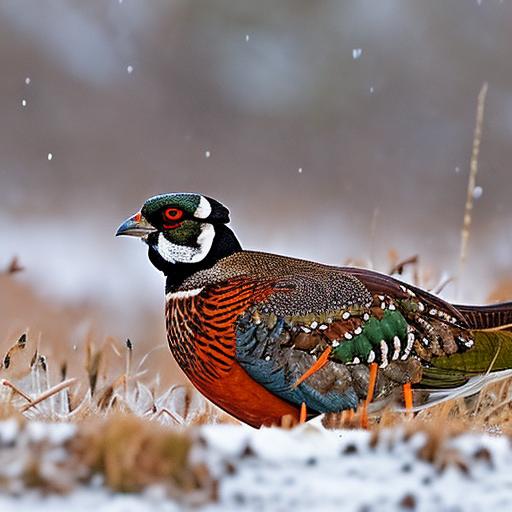
Snow Secrets Revealed: The Ultimate Guide to Pheasant Hunting in Snow

Table of Contents
Introduction
There’s a certain kind of magic that blankets the world when the first snowflakes fall. The serenity of the snowy landscape can be almost surreal, but there’s more to it for those of us who thrive on the thrill of the hunt. Pheasant hunting in snow, in particular, offers an unmatched experience. Now, if you’ve never tried it or if you’re wondering how different it could possibly be from hunting in milder weather, you’re in for a delightful surprise.
When pheasant hunting in snow, every step you take seems to be accompanied by the hush of winter, making the heartbeats and distant calls of pheasants all the more prominent. The pristine snow, painted with the footprints of your elusive quarry, narrates a story only seasoned hunters can read. And as someone who’s trekked countless miles chasing the thrill of upland game in the winter wonderland, I’m here to guide you through the beauty, the challenges, and the pure exhilaration of pheasant hunting in this frosty season.
Understanding Pheasant Behavior in Snowy Terrains
Pheasants’ Adaptations to Cold Climates
Pheasants are resilient birds. When winter drops its white curtain, they don’t just pack their bags and head south. Instead, they’ve evolved a set of unique adaptations to face the cold head-on, and understanding these can be a real game-changer for hunters. Their body feathers become denser, providing an added layer of insulation. This keeps them warm, sure, but it also means they’re less likely to range far in search of food. For us hunters, this implies that pheasants become more predictable in their movements during snowy days.
Typical Hiding Spots and Feeding Patterns
So, where do these birds go when the world’s covered in a blanket of white? Well, they’re ground-dwelling birds, to start with. In snowy conditions, pheasants tend to hunker down in thicker brush or tall grass patches where snow might not have penetrated as deeply. This provides them both protection from the elements and predators. For food, they’ll typically venture to crop fields, foraging for leftover grains or any plants that manage to poke through the snow. As a hunter, keep an eye out for these spots; they’re likely where you’ll find the most action.
Snow and Pheasant Vocalizations
Now, here’s something fascinating. Ever noticed how different the world sounds after a fresh snowfall? Snow has this unique ability to absorb sound, making everything seem quieter. Pheasants, relying heavily on their calls to communicate, especially during mating seasons, adapt their vocalizations in snowy conditions. Their calls might become louder, sharper, or even more frequent to compensate for this sound absorption. For the seasoned hunter, this presents an exciting opportunity. Not only can you hear these calls clearer in the silent snowy landscapes, but with a bit of practice, you can also pinpoint the exact direction and estimate the distance to the calling bird.

To truly excel in pheasant hunting in snow, it’s essential to get into the mindset of the bird. Understanding their behavior, habits, and communication can make the difference between returning home with tales of the one that got away and having a triumphant hunting story to share.
Essential Gear for Snowy Hunts
Proper Attire: Layering for Warmth and Mobility
When it comes to pheasant hunting in snow, dressing for the occasion isn’t just about looking the part; it’s about survival. In the frosty embrace of winter, your first line of defense is your attire. Layering is the golden rule here. Start with moisture-wicking base layers to keep sweat at bay. Mid-layers, preferably wool or synthetic fleece, trap body heat, and on the outside, go for a waterproof, breathable shell. But remember, bulky doesn’t necessarily mean warmer. The trick is to strike that balance, ensuring you’re toasty but not waddling around like an overburdened mule. Mobility is key, especially when you’re maneuvering for that perfect shot.
Specialized Gear: Footsteps in the Snow
Ever tried chasing pheasants in soggy socks? Yeah, not fun. Snow boots are a must, ensuring your feet remain dry and warm. Look for ones with sturdy, slip-resistant soles; the last thing you want is to be that hunter who lost a pheasant because they were too busy moonwalking on icy terrain. Pair those boots with gaiters to keep snow out of your boots and insulated gloves to ensure those fingers are nimble and ready to react.
Equipment Adaptations: Blending and Functioning in a Snowscape
Alright, here’s where the magic happens. Pheasant hunting in snow offers a completely different backdrop, and that means regular gear might just stand out like a sore thumb. Using snow covers for blinds is a smart move. They seamlessly merge with the surroundings, giving you that camouflage advantage. Speaking of camouflage, ever thought of white camo? In a snowy landscape, it’s your best friend, allowing you to blend effortlessly.
Now, a brief word on firearms. Freezing temperatures can be tricky. Metal gets cold, mechanisms jam, and moisture can be your worst enemy. It’s worthwhile investing in weatherproofing your firearm. And always, always check its functionality in colder temperatures before heading out. A malfunctioning firearm in the middle of a snowy hunt isn’t just disappointing; it can be downright dangerous.
Piecing together the right gear for pheasant hunting in snow can feel a bit like assembling a jigsaw puzzle. Each item, though seemingly trivial on its own, plays a crucial role in the bigger picture. The right attire keeps you warm, specialized gear ensures comfort and safety, and the right equipment adaptations can be the difference between a triumphant day and a lesson in humility. So gear up wisely, and let the snowy hunts begin!
Strategies and Tactics to Improve Your Snowy Hunt
Using Snow to Your Advantage: The Art of Tracking
Snow, while it presents its own set of challenges, can be a hunter’s greatest ally. One of the most significant advantages it offers is the clear trail of pheasant footprints. These tracks can tell a story – the direction the bird is moving, how recently it passed, even its pace. But it’s not just about following footprints. Look for signs of feeding, such as disturbed snow or areas where they’ve dug down to reach food. These patterns can give you insights into their daily routes, favored spots, and most active times.
Stealth in Snow: Mastering the Quiet Crunch
Snow’s silence is both a gift and a challenge. The same white powder that muffles pheasant calls can amplify your footsteps, turning a gentle stride into a cacophony of crunches. The key to stealth in snow lies in understanding its types. Fresh, powdery snow tends to be quieter, while the wet, compacted kind? Well, that’s where the noise starts. To minimize your sound, try to step gently, placing the heel first followed by the toes. It’s a slow process, yes, but in the quiet game of pheasant hunting in snow, it pays to be the silent stalker.
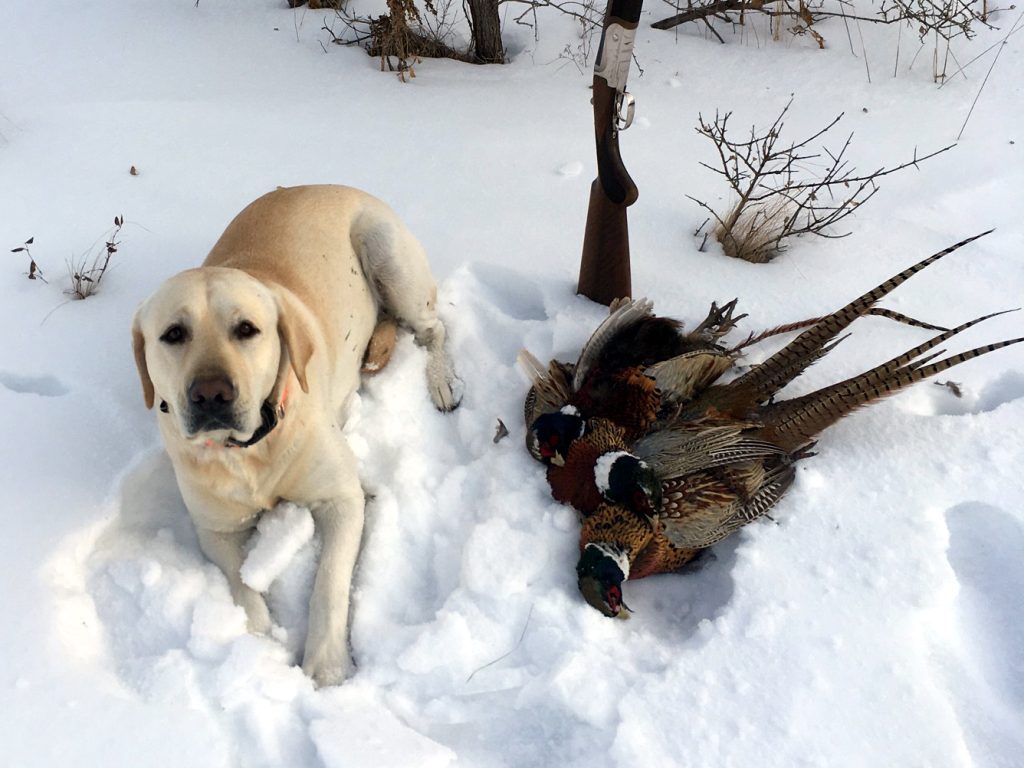
Perfecting Your Shot: Snow’s Role in Visibility
Snow can be deceptive. The bright, reflective surface can mess with depth perception and make distances hard to judge. Plus, the glare from snow, especially on sunny days, can make it challenging to spot a pheasant against the backdrop. To overcome this, consider using polarized sunglasses or scopes to reduce glare. When taking your shot, patience is crucial. Wait for the bird to contrast against a darker background, like trees or brush, to ensure you’ve got a clear line of sight. Additionally, if snow’s falling while you’re out, remember that it can slow down your shot ever so slightly. Compensate by leading your target a touch more than you usually would.
To summarize, when it comes to pheasant hunting in snow, every element of the environment plays a part in your strategy. The snow beneath your feet can guide or betray you, the silence can be your cover or your downfall, and the very air, chilled and crisp, can influence your shot. Embrace these challenges, adapt to them, and you’ll find that winter offers some of the most rewarding hunting experiences out there.
Safety Considerations in Winter Hunts
Preventing Hypothermia: Staying Warm and Aware
Hypothermia isn’t just an inconvenience; it’s a deadly threat that lurks in the shadows of every snowy hunt. Recognizing the symptoms early can mean the difference between a successful hunt and a dangerous situation. Initial symptoms include shivering, numbness, fatigue, and confusion. If you or a hunting buddy start exhibiting these, it’s time to take action. Layer up, and most importantly, ensure you stay dry. Wet clothing, even from sweat, can decrease your body’s temperature rapidly. Bringing a thermos of hot drink or soup can also provide some much-needed warmth from the inside out.
Safe Firearm Handling in Freezing Conditions
Cold metal, cold hands—these can be a disastrous combo if you’re not careful. Firearms have a tendency to behave unpredictably in freezing conditions. Lubricants can gum up, causing malfunctions, and metal can contract, potentially affecting your firearm’s performance. Regular checks and maintenance are crucial. Additionally, ensure you’re wearing insulated gloves, not just for warmth, but to prevent frostbite when handling the cold metal of your gun.
Snow Safety: Treading with Care
The winter landscape, blanketed in snow, might seem serene, but it hides its fair share of hazards. Those breathtaking frozen lakes? They can be ticking time bombs if the ice isn’t thick enough. Always test ice thickness before stepping onto a frozen body of water, and it’s a good idea to avoid them altogether if you’re unsure. Snow-covered ditches or deep holes can also pose a risk. One wrong step, and you could find yourself in a precarious situation. Using a trekking pole or even the butt of your gun to test the ground in front of you can prevent unexpected tumbles.
Safety during pheasant hunting in snow cannot be overstressed. Nature, while majestic in its snowy attire, doesn’t play favorites. Respect its power, be prepared, and always keep safety at the forefront of your hunting strategies. Remember, the real trophy of any hunt isn’t the game you bring back, but the stories of camaraderie and the assurance that everyone returns home safe and sound.
Related Questions
How does snow affect the flight pattern of pheasants?
Great question! Snow can definitely influence pheasant behavior. When the ground is blanketed in white, pheasants may be less inclined to take long flights because they rely on ground cover to escape predators. Instead, they might opt for shorter, more low-altitude bursts. This can be a double-edged sword for hunters. On one hand, the birds might be more predictable in where they land; on the other, their rapid, close-to-the-ground takeoffs can be challenging targets!
Are there any changes in regulations or laws for hunting in the snow?
Well, snow-specific regulations aren’t super common, but winter hunting can have its own set of rules. Always check local guidelines before heading out. In some areas, certain trails or lands may be off-limits during winter months to protect local ecosystems. Additionally, daylight hours are shorter, so hunting times might be adjusted. My pro tip? Always keep an updated set of local regulations on hand and stay informed. Safety and respect for the rules make for the best hunts!
How do dogs cope in snowy hunts? Are there breeds better suited for such conditions?
Oh, our four-legged hunting buddies! Dogs, in general, bring enthusiasm to the hunt, snow or shine. However, breeds like the Labrador Retriever, German Wirehaired Pointer, or the English Springer Spaniel are especially adapted for cold conditions, thanks to their thicker coats and robust builds. If you’re bringing a breed with a shorter coat, consider a dog vest to keep them warm. Also, watch their paws for ice build-up. Whichever breed you choose, monitor their comfort and energy levels in the cold.
Is there a best time of day for pheasant hunting in the snow?
In the snowy landscapes, mid-morning to early afternoon can be a sweet spot for pheasant hunting. The sun’s up, slightly warming the earth and encouraging pheasants to move around and feed. Early morning, when everything’s still very frosty, pheasants might still be hunkered down. And as the day winds down, they’ll start seeking out their roosting spots. That midday window is when you’re likely to see the most action.
Summary
As we pull our gear together after a day’s hunt, watching the amber horizon swallow the sun and listening to the distant echo of pheasant calls, there’s an undeniable satisfaction that comes from pheasant hunting in snow. The frigid challenge, the stark beauty, and the raw connection with nature are unparalleled. Each snow-covered blade of grass, every muted sound, and the patterns of pheasant tracks weaving a tapestry on the white ground; all of these make for moments that are etched in the annals of a hunter’s memory.
Pheasant hunting in snow is not just about the game; it’s about embracing the elements, tuning into the subtle whispers of nature, and respecting the resilience of the creatures we pursue. If there’s one thing I hope you take away from our journey through the snow-kissed wilds, it’s this: there’s more to hunting than the shot. It’s the experience, the memories, and the stories we gather along the way. So, the next time snow blankets the earth, gear up, venture out, and discover the magic of pheasant hunting in snow for yourself.

Herb has been a longtime lover of the outdoors. Whether it be hunting, camping, fishing or just getting outside to reset. Proud father and animal lover. Bourbon anyone?

by
Comments
4 responses to “Snow Secrets Revealed: The Ultimate Guide to Pheasant Hunting in Snow”
-
[…] shot types, a #4, #5, or #6 lead shot is typical for pheasant hunting. These sizes offer a good balance between range and pellet density, ensuring that when you do line […]
-
[…] to highly rewarding experiences in the field. Let’s delve into a few of these alternative hunting methods that can help you catch pheasants without relying on a […]
-
[…] If you’re interested in Kentucky elk guides, you might also enjoy reading about pheasant hunting in the snow. Check out this informative article from Old Oak Syndicate that provides tips and techniques for hunting pheasants in snowy conditions. Whether you’re a seasoned hunter or just starting out, this article will give you valuable insights on how to navigate the challenges of hunting pheasants in winter. So grab your gear and get ready for an exhilarating adventure in the snow! Read more […]
-
[…] If you’re an avid hunter in Iowa, you may be interested in expanding your hunting repertoire beyond elk. One related article that could catch your attention is “Pheasant Hunting in Snow: Tips and Tricks for a Successful Hunt.” This article provides valuable insights on how to navigate the challenges of hunting pheasants in snowy conditions. From choosing the right gear to adjusting your hunting strategies, this article offers practical advice for hunters looking to make the most of their winter pheasant hunts. Check it out here. […]

Categories
- Big Game Hunting (301)
- Deer (202)
- Reviews (3)
- Shooting (16)
- Slingshot (1)
- Small Game Hunting (42)
- Upland Hunting (126)
- Waterfowl Hunting (3)


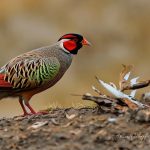
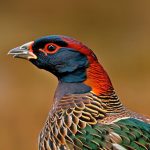
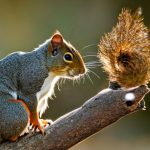
Leave a Reply